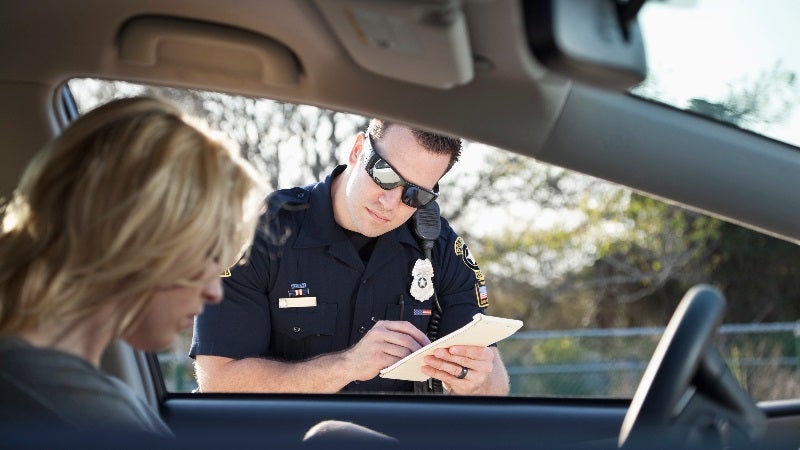2025 Drunk driving statistics

Alcohol is a leading cause of traffic fatalities because it severely impairs a driver’s judgment and reaction time. Drinking and driving kills 37 people a day in the U.S. — about one person every 39 minutes — according to the National Highway Traffic Safety Administration (NHTSA). That is more than 11,000 lives lost each year to drunk driving, which is why it’s illegal to operate a vehicle while under the influence of alcohol in all 50 U.S. states, Washington, D.C. and Puerto Rico.
- A driver is considered legally impaired when their blood alcohol concentration (BAC) measures 0.08 or higher.
- One alcohol-related death occurs every 39 minutes in the U.S. (NHTSA).
- Drunk driving accidents are responsible for 11,000 deaths every year, and about 1/3 of all traffic-related deaths (NHTSA).
- In 2022, more than 280 children were killed in drunk-driving crashes (NHTSA)
- Drinking and driving costs more than $58 billion in deaths and damages annually.
- The consequences of driving under the influence are severe. A first-offense DUI can cost $10,000 or more in fines and legal fees.
- In 2022, the number of fatal accidents involving alcohol climbed to 32% of all traffic accidents.
- Drunk driving accidents are statistically most likely to occur during the summer months, especially July (National Safety Council).
Drunk driving deaths per year
Drinking and driving kills more than 11,000 people each year, with alcohol-related traffic fatalities making up just over 30 percent of all traffic fatalities each year. The table below includes a breakdown of the total traffic fatalities and alcohol-related traffic fatalities between 2018 and 2021.
| Year | Total traffic fatalities | Alcohol-related traffic fatalities | % of fatalities from alcohol |
|---|---|---|---|
| 2021 | 42,915 | 13,384 | 31% |
| 2020 | 38,824 | 11,654 | 30% |
| 2019 | 36,096 | 10,142 | 28% |
| 2018 | 36,560 | 10,511 | 29% |
Source: NHTSA Traffic Safety Facts Annual Report
Drunk driving statistics 2025
According to data from the NHTSA, drunk driving statistics vary significantly based on age, gender and location. Young people, motorcyclists and drivers with prior DUI convictions are the most likely to drive under the influence.
Age
Young people are the most at-risk for drunk driving. NHTSA data shows that drivers between the ages of 21-24 account for 29 percent of all fatal alcohol-impaired crashes, followed closely by 25-34 year olds (28 percent). However, the implementation of minimum-drinking-age laws has been shown to save over 30,000 lives.
In the table below, you can see which age brackets have the highest instances of alcohol-impaired crashes:
| Age bracket | % of alcohol-impaired drivers involved in fatal crashes |
|---|---|
| 16 – 20 | 19% |
| 21 – 24 | 29% |
| 25 – 34 | 28% |
| 35 – 44 | 24% |
| 45 – 54 | 20% |
| 55 – 64 | 17% |
| 65 – 74 | 12% |
| 75+ | 8% |
Source: NHTSA
Gender
NHTSA data also reveals that men are more likely to drive drunk than women. According to 2019 FBI data, men accounted for roughly 74 percent of people arrested for drunk driving.
Drunk driving statistics by state
Although drunk driving is a serious issue affecting the entire country, the rate of alcohol-related accidents and traffic fatalities is higher in some states. According to NHTSA data from 2022, the states with the highest number of annual alcohol-related traffic fatalities are:
- California (4,428)
- Texas (4,408)
- Florida (3,530)
Conversely, the states (not including Washington, D.C.) with the lowest number of annual alcohol-related traffic fatalities are:
- Rhode Island (52)
- Vermont (76)
- Alaska (82)
Drunk driving fatalities tend to occur more often in populous states. Adjusting for population, the states with the highest percentage of fatal accidents caused by drunk driving include:
- Rhode Island and South Carolina (43%)
- Texas (42%)
- Oregon (39%)
On the other hand, the states with the lowest percentage of fatal accidents caused by drunk driving are:
- Utah (22%)
- West Virginia (23%)
- Alaska, Arkansas, Kentucky, Mississippi (24%)
In the table below, you can see the state-by-state breakdown of total traffic fatalities, total alcohol-related traffic fatalities and the percentage of all fatalities that involve drunk driving:
| State | Total fatalities | Total alcohol-related fatalities | % of all fatalities involving alcohol |
|---|---|---|---|
| Alabama | 988 | 327 | 33% |
| Alaska | 82 | 21 | 25% |
| Arizona | 1,302 | 522 | 40% |
| Arkansas | 643 | 200 | 31% |
| California | 4,428 | 1,711 | 38% |
| Colorado | 764 | 317 | 41% |
| Connecticut | 359 | 151 | 42% |
| Delaware | 162 | 58 | 36% |
| District of Columbia | 32 | 14 | 44% |
| Florida | 3,530 | 1,100 | 31% |
| Georgia | 1,797 | 600 | 33% |
| Hawaii | 116 | 47 | 40% |
| Idaho | 215 | 79 | 37% |
| Illinois | 1,268 | 552 | 43% |
| Indiana | 949 | 325 | 34% |
| Iowa | 338 | 143 | 41% |
| Kansas | 410 | 136 | 33% |
| Kentucky | 744 | 205 | 27% |
| Louisiana | 906 | 324 | 36% |
| Maine | 182 | 79 | 43% |
| Maryland | 564 | 227 | 40% |
| Massachusetts | 434 | 145 | 33% |
| Michigan | 1,124 | 361 | 32% |
| Minnesota | 444 | 153 | 34% |
| Mississippi | 703 | 191 | 27% |
| Missouri | 1,057 | 368 | 35% |
| Montana | 213 | 84 | 39% |
| Nebraska | 244 | 89 | 36% |
| Nevada | 416 | 170 | 41% |
| New Hampshire | 146 | 58 | 39% |
| New Jersey | 685 | 215 | 31% |
| New Mexico | 466 | 179 | 38% |
| New York | 1,175 | 444 | 38% |
| North Carolina | 1,630 | 530 | 32% |
| North Dakota | 98 | 41 | 42% |
| Ohio | 1,275 | 566 | 44% |
| Oklahoma | 710 | 218 | 30% |
| Oregon | 601 | 271 | 45% |
| Pennsylvania | 1,179 | 394 | 33% |
| Rhode Island | 52 59 | 28 | 54% |
| South Carolina | 1,094 | 536 | 49% |
| South Dakota | 137 | 54 | 39% |
| Tennessee | 1,314 | 436 | 33% |
| Texas | 4,408 | 2,159 | 49% |
| Utah | 319 | 88 | 28% |
| Vermont | 76 | 34 | 45% |
| Virginia | 1,008 | 448 | 34% |
| Washington | 733 | 311 | 42% |
| West Virginia | 264 | 80 | 30% |
| Wisconsin | 596 | 198 | 33% |
| Wyoming | 134 | 49 | 36% |
Source: NHTSA
Public perception of drunk driving
Most drivers understand the seriousness of drunk driving and the consequences it can bring, financially, legally and morally. Data shows that many U.S. drivers are concerned about the prevalence of drunk driving in the country, but a surprising number of people admit to driving under the influence of alcohol.
According to the Traffic Injury Research Foundation’s (TIRF) 2022 report and survey:
- The percentage of U.S. drivers who reported being “very or extremely concerned” about drunk driving fell from 65% in 2021 to 59% in 2022.
- The number of drivers who drove when they thought they were over the legal BAC limit decreased from 22.5% in 2021 to 19.6% in 2022.
- Of these respondents, 9.3% thought they wouldn’t get caught, and 30.7% thought that despite being over the legal limit, they were still okay to drive.
- Men were 67.8% more likely to report driving when they thought they were over the legal limit than women. Men were also 61.8% more likely than women to report driving impaired often or very often.
- 13% of respondents aged 21-29 reported driving under the influence often or very often, compared to only 7.8% of those aged 50-59 years.
How is the rate of drinking and driving changing?
Despite the persistent efforts of citizen activist groups like Mothers Against Drunk Driving (MADD) and public agencies like the NHTSA and CDC, the rate of drunk driving is steadily increasing after years of showing a decline.
Drunk driving fatalities were at their lowest in 2011 and 2014, but fatalities have been on the rise nationally since 2019. Researchers believe that the drunk driving rate might be leveling off following these elevated pandemic rates, with about 20 states showing decreased fatality rates in 2022.
With these considerations in mind, lawmakers and the NHTSA are pushing for car manufacturers to incorporate drunk and impaired driving prevention technology into new vehicles. MADD is also pushing for more urgent public awareness campaigns.
Historical data reflects these developments:
- The volume of drunk driving deaths has decreased from 41% of all crash deaths in 1985 to 31% in 2021.
- According to the NHTSA, alcohol-impaired-driving fatalities decreased 53% from 1982 to 2011.
- The overall drunk driving fatality rate fell between 2016 and 2019 but began rising in 2020.
The Foundation for Advancing Alcohol Responsibility states, “Since 1982, drunk driving fatalities on our nation’s roadways have decreased 36 percent, while total traffic fatalities have declined 3 percent.” However, the organization notes that, “We still have more work to do, and our commitment to eliminate drunk driving is stronger than ever.”
The consequences of drunk driving
There’s no denying that driving drunk can change your life for the worse. What would happen if you drove under the influence and killed a passenger in your car, or another driver? How would your loved ones cope if you lost your life in a drunk driving accident? Getting into an accident while under the influence can lead to serious legal action, like vehicular manslaughter, which can carry a long prison sentence.
No one likes to think that a few drinks can negatively impact the rest of your life, but it’s the truth. Here are a few consequences that are associated with drunk driving.
Drunk driving and car insurance rates
Even if you can avoid physical injury to your person or another driver, a conviction for driving under the influence will have a significant impact on the cost of your car insurance. When you have a DUI or DWI on your record, car insurance companies generally assess you as a high-risk driver and increase your premiums to cover that increased risk.
These premium statistics can give you an idea of what to expect:
- The average full coverage car insurance premium for drivers with a clean record is $2,638 per year.
- After a DUI, the average full coverage car insurance premium jumps to $5,106 per year.
- Full coverage car insurance increases by an average of 94 percent following a DUI conviction while minimum coverage increases by an average of 97 percent.
Be aware that after a DUI or DWI conviction, some insurance providers may drop you or classify you as a high-risk driver. If your insurance provider cancels or nonrenews your coverage, you might have to shop for an insurer that provides high-risk coverage. You may also have to switch carriers if you’re required to comply with SR-22 filing to prove you carry the minimum amount of coverage your state mandates.
Legal implications of drunk driving
Drunk driving laws have changed significantly over the years, and states have taken the initiative to add their own specifications in addition to federal traffic laws. Impairment offenses can be classified as misdemeanors or even felony offenses, often resulting in fines, loss of your driver’s license and even jail time.
While repeat DUI offenders typically face jail time and permanent license revocation, first-time offenders can be ordered to pay more than $10,000 in fines and legal fees, and can face temporary license suspension. If you cause an accident while drunk and there are injuries or fatalities, the legal consequences are much more severe.
How to prevent drunk driving
Public attitude toward drinking and driving continues to shift as more and more families are affected by the negative consequences of alcohol. Today, there is a lot more education and many more laws, all designed to prevent driving under the influence, particularly among new drivers.
If you are a parent or caregiver, it’s important to educate your kids about the consequences of drinking and driving. Data shows that young adults between the ages of 21-24 have the highest rates of drunk driving fatalities. Here are a few ways that drunk driving can be prevented:
- Talk to your child. If you have new drivers at home, educate them on the importance of not drinking and driving as soon as they get their driver’s license. Be sure they understand the extreme consequences it can have from a legal perspective, not just getting in trouble at home. Offer your child alternatives to drinking and driving, and emphasize that calling for a ride home is always better than driving if you’ve been drinking.
- Plan alternative transportation. If you plan to drink, map out a plan to get home safely with a designated driver, cab, rideshare app or public transportation. If transportation options are limited, consider spending the night with a friend or family member whose home is accessible.
Driving drunk is never the right choice.
Methodology
Bankrate utilizes Quadrant Information Services to analyze January 2025 rates for all ZIP codes and carriers in all 50 states and Washington, D.C. Rates are weighted based on the population density in each geographic region. Quoted rates are based on a single, 40-year-old male and female driver with a clean driving record, good credit and the following full coverage limits:
- $100,000 bodily injury liability per person
- $300,000 bodily injury liability per accident
- $50,000 property damage liability per accident
- $100,000 uninsured motorist bodily injury per person
- $300,000 uninsured motorist bodily injury per accident
- $500 collision deductible
- $500 comprehensive deductible
To determine minimum coverage limits, Bankrate used minimum coverage that meets each state’s requirements. Our base profile drivers own a 2023 Toyota Camry, commute five days a week and drive 12,000 miles annually.
These are sample rates and should only be used for comparative purposes.
Incidents: Rates were calculated by evaluating our base profile with the following incidents applied: clean record (base) and single DUI conviction.
You may also like


Arkansas car insurance laws: What you need to know

How insurance raises the total cost of a DUI



